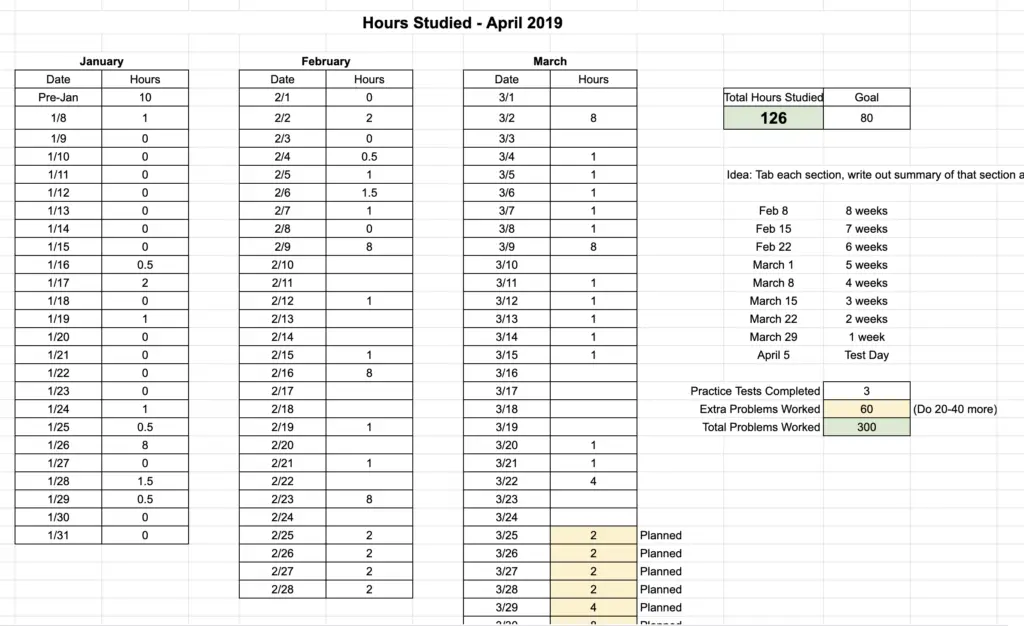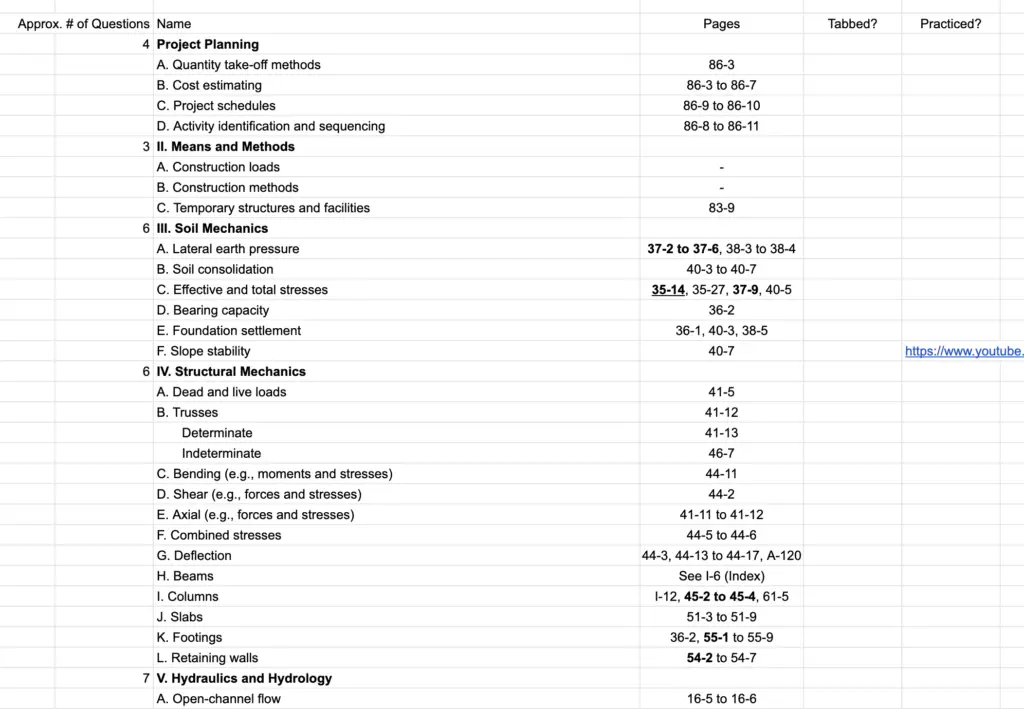As I was getting closer to the four years of engineering experience required to become a PE, I started wondering how I was going to pass the PE exam. I had no clue what the test was like, how to study, what materials to bring in, or anything. I really wish I’d had someone to give me some tips for the PE exam to help me figure it all out.
In this article I’ve summarized some of my best PE Exam tips to help you be completely prepared for test day.
1. Set aside time to make a study plan
Trying to figure out where to start studying for the PE exam is overwhelming. It feels like you should know how to study since you did it so much in college. But the reality is, it’s probably been a long time since your last midterm exam, so you’ll need to take time to set yourself up to study the right way.
Before I started studying, I put everything I was thinking about studying into a spreadsheet. I made a sheet for tracking my hours studied and how many problems I studied. I highly recommend you do the same.

I also listed out the exam specifications and design standards to make sure I was studying each of those. That’s where my next tip comes in.
2. Use the exam specifications and design standards to guide your study
You’ll need to know what topics are covered on the PE exam if you’ll have any hope of passing. NCEES lists all of these for you in one place, and you can access them right here under the heading “Exam specifications and design standards.”
While studying I focused mainly on this to make sure I was fully prepared. A lot of prep material has its own way of organizing the topics, especially the Civil Engineering Reference Manual.
Make sure to keep the exam specifications handy by either printing them or putting them into your study plan spreadsheet to make sure you’re covering each topic no matter what preparation materials you use.

But that’s where our next tip becomes really important because it kind of does all the work of making a study plan for you.
3. Purchase a course
The first time I took the PE exam I failed. I really had to pass the second time, so I pulled out all the stops and bought School of PE’s review course and it helped me pass! It was a lot of money, but it saved me a ton of time and headache trying to create a study plan and made test day WAY easier!
That’s because the entire course is centered around the NCEES exam specifications. When I went in to take the test, not a single question surprised me, unlike the first time. I was so much more confident the second time and it was so much easier to study. I know review courses are a lot of money but if you have to pass on your next attempt, invest in yourself and get one! You’ll be so glad you did.
If you’re curious about School of PE, you can read my review of it right here. Or you can click here to get a free trial that lets you have access to a few video lectures to see if you like it!
One hint though is that the trial doesn’t even begin to do the whole course justice. You’ll be blown away by how good it is once you purchase the full course!
4. Don’t take your practice tests at first
You’ll want to work a lot of problems, which we’ll get to in a moment. But one of the best things I did that really helped was that I saved my version of the NCEES practice exam until just a couple of weeks before the test. I had worked a lot of problems and made a plan to set up a situation very similar to the actual exam.
By waiting, I was able to simulate the test with NCEES’s practice exam so it was as much like the real thing as possible. If I had taken that first, it would have been hard to do a practice run!
I set aside an entire Saturday, packed a lunch, went to my university and found a quiet place, and gave myself 8-hours, with a 1-hour lunch break in the middle, to complete the practice exam. When test day came around, it didn’t feel completely new, which was a big deal in making the day go more smoothly!
5. Focus on working problems more than anything else
This is one tip that I did get from a coworker that really saved my life. I was worried about having to do a ton of reading to prepare because reading Civil Engineering content is super boring most of the time!
But this coworker was very specific and very clear that the best way to study is just to work as many problems as possible.
Over the course of the two times I had to take the PE, I did over 900 problems. The first time I did only 300 but I didn’t have a course. When I bought the School of PE review course, however, I got an additional 600 problems to work, which made it way easier! They were also the most like the actual exam than most other practice problems I did!
6. Read the NCEES examinee guide
The examinee guide tells you everything you need to know about test day. It’s especially important because it goes over the policies to follow to make sure you get into the exam and don’t get kicked out.
It walks you through pretty much everything about the PE exam, including the testing center, costs of the exam, format, and more. You can get a copy of the NCEES examinee guide right here.
7. Skip problems that are hard
When you’re taking the actual PE exam you’ll come across some problems that are more difficult. You’ll also see some that you might not be as well prepared for. It’s best to skip these and come back to them later so you can focus on finishing the problems that you do know how to solve.
The reason is that if you were to spend 15 minutes on a couple of problems, that eats up time you could be using to answer easier questions that you know you can get right. You may end up getting to the end of the 4-hour limit for that section and find you’ve not even looked at the last 10 questions or so because you got so stuck trying to solve one hard problem.
You’ll be a lot better off guessing on just 2 or 3 problems rather than missing 10 because you ran out of time! And remember, 40 problems in 4 hours comes to about 6 minutes per problem, so stick to that time limit when practicing!
8. Take a short break every hour while taking the exam
When I took the PE I’d take a couple of minutes each hour to stretch my arms, roll my head around, and just stare at the wall or ceiling to let my brain get a bit of a rest before continuing. This also helped break up the test to make it not so overwhelming. It was also a good time to go to the bathroom!
I also used this time to check in with myself to see if I needed to have a snack, drink some water, or move a leg that was falling asleep. I didn’t do this myself, but if you really wanted to you could take a break and go to the bathroom just to stretch your legs, but be careful not to eat up too much time with this!
9. Pack a lunch
Test day can be pretty stressful no matter how well you’ve prepared, but there are still a lot of things you can do to reduce that stress. One of the best is to pack a lunch if at all possible.
The problem with going out to eat comes down to two things:
- You never know if the place you go will be busy. You absolutely don’t want to risk being late to the afternoon portion of the exam.
- Fast food is bad for your brain, which will make you perform worse on the afternoon portion, which is harder than the morning.
When you pack a lunch, you can get rid of both of these problems and significantly reduce stress on test day. You can go straight to your car, eat your lunch, and even have time to take a brief walk or do something to relax your mind.
Plus, you can choose foods that will boost your brainpower like avocados, blueberries, and dark chocolate.
10. Drive to the testing center a few days before the test
In the book The Power of Habit, the author mentions a study in which rats were put through a maze and scientists studied their brain activity. What the researchers found was that the first time through the maze, the rats’ brains were lit up with activity trying to figure it all out. But as they kept going through it, their brains calmed down.
Whenever you’re in an unfamiliar situation, your brain is fully engaged trying to process everything. But if you know what to expect, like by taking a practice exam or by knowing where the testing center is before test day, you can reduce some of that activity, leaving you with more brainpower to focus on passing the test.
Plus it really calms your nerves!
11. Stop studying a couple of days before the test
A couple of years ago I ran a marathon. As part of my preparation for race day, I had to take a break and run only a little in the couple of days before the race. This is a common practice among marathoners, and because the PE exam is like a marathon for your brain, it’s best to do the same and take time off to relax before you go in.
I did this myself and even took those days off work. I played video games, watched TV, spent time with my family, and whatever else I wanted to do to have a little fun and rest my brain.
When it came time for test day I was fully rested and not burnt out from studying all that week! I was a lot more relaxed and the went much more smoothly than it would have had I tried to cram a bunch of studying in right before test day.
Conclusion
The PE Exam isn’t easy, but if you follow the advice of those who have already taken it, it will go much more smoothly. I had to take it twice to pass and become licensed, so I know that these tips work because I used them myself to pass!
I hope these will help you have a better time on test day and that you’ll pass the PE on your first (or next) try!

